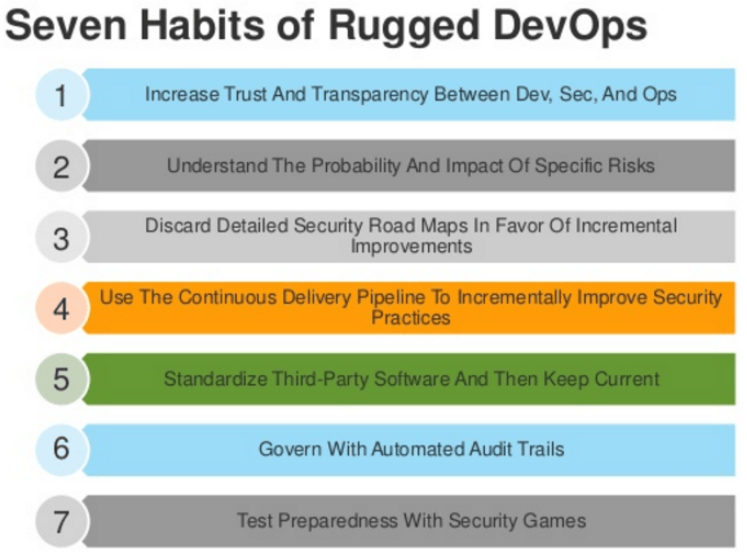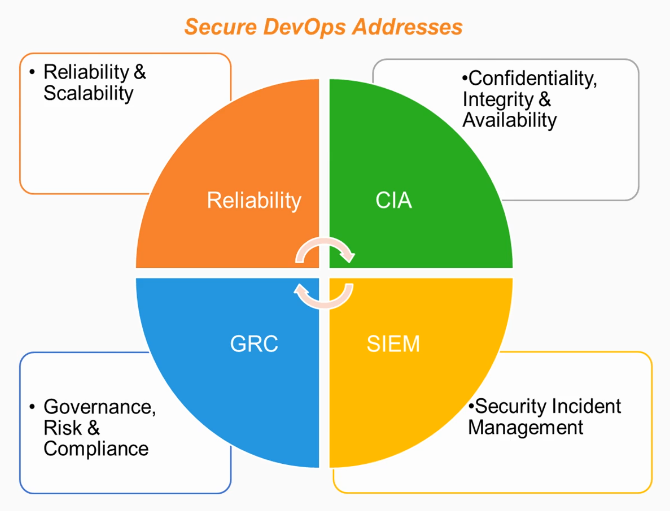Adopting DevSecOps
- DevOps to Accelerate Digital Transformation
- Avoid Late Security Checks
- Enter the “Rugged Manifesto”
- Secure Devops for Application Security
- Business-Driven Strategies
- OWASP Security Guidelines
- Resources
DevOps to Accelerate Digital Transformation
As a refresher, the different phases of DevOps include:
- Planning
- Business features are defined
- Backlogs are created and tasks are prioritized
- Impementing Scrum and Kanban
- Coding
- Implementation of small chunks of software untis
- Automated builds are versioned and stored in repository
- Testing
- Automation suites are used
- Perform code covergae and dynamic analysis
- Implement techniques such as Test-Driven Development (TDD)
- Release
- CICD Pipeline is leveraged
- End-to-end testing, making software ready for deployment
- Deployment
- Utilize tools such as Ansibel, uppet, and Chef for configuration management
- Operate
- Monitor systems through metrics, alerts, and health checks
Avoid Late Security Checks
Avoiding security checks that are late in the release cycle prevents:
- slower release cycles and slower throughput
- Higher cost
- Breakdown of Agile and DevOps practices
Seucrity threats are constantly evolving and organizations require application with improved response to these threats. As a possible solution, we can follow the “Rugged Manifesto”.
Enter the “Rugged Manifesto”
“Rugged” describes software development organizations that have culture of rapidly evolving their ability to create available, survivable, defensible, secure, and resilient software.
- Security as the primary consideraton at every phase
- Makes DevSecOps and DevOps are both critical in an environment
- Adds robust security methods to traditional DevOps practices
- Add increased trust, transparency, and clearer understanding of probable risk
- Adopt security measure into all stages of software design and requirements

Secure Devops for Application Security
DevSecOps signifies a shift in security as it orchestrates and integrates config management.
Planning:
- Address security at planning stage
- Prepare threat modelling and data flow diagram
Coding:
- Security architecture should be done with code inspector and environment hardening
- Choose security tools and solutions that integrate within the development environment
Testing:
- Interactive applications can help in instrumenting the app from the inside
- Perform other activites such as protocol and input fuzzing, and application vulnrability correlation
Release Phase:
- Further security checks can be done, such as penetration testing
Deployment Phase:
- Harden the system
- Binary is signed and timestamped in the config phase
- Signatures are checked before deploying to the CICD pipeline
- Perform chaos testing to observe how application behaves in unsual circumstances
Operate:
- Check signature of binaries
- Focus on configuration assurance at instantiation by security controls
Monitor:
- Not all vulnerabilities will be identifies, and some may reach production
- Continuous monitoring can check for irregular behavior in production

Business-Driven Strategies
Strategy 1: Being Security Champs into the Devops Organization
- Foster mutual respect between developers, security, and business professinals
- Invite security experts into the DevOps team to balance the priorities
- Emphatize with the Security experts
- Learn all of your product’s vulnerabilities
Strategy 2: Integrate Security into DevOps Processes
- Align processes to enable delivery speed
- Treat all feature and defects alike
- Collaborate to build relationships and speed response
- Adopt “incremental mindset”; embrace incremental changes
Strategy 3: Integrate Security Technology into DevOps Tools
- “Shift-left” security, which means considering security at the early stage pf the project
- Govern with automatic audit trails
- Add security to quality gates Use output data from security and testing tools
- Test preparedness withs ecurity games
OWASP Security Guidelines
The Open Web Application Security Project® (OWASP) is a nonprofit foundation dedicated to improve the security of software. OWASP provides resources on methodologies, tools, and technologies in the field of application security.
The OWASP Top 10 is a standard awareness document for developers and web application security. It represents a broad consensus about the most critical security risks to web applications.
